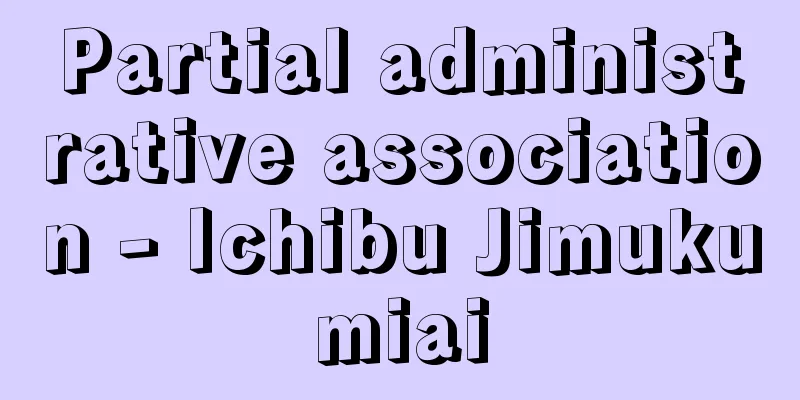Land Reform

|
Generally, the term refers to the land reform (1946-50) that was implemented as an important part of the occupation policy when Japan was occupied by the Allied forces after World War II. Before the war, agriculture in Japan held an important position and role in the Japanese capitalist economy. Even in 1940, agricultural workers made up 41% of the total workforce, and agriculture, forestry, and fisheries accounted for 24% of the national income. In agriculture, the majority of farmers were small-scale farmers, with the average cultivated land area per farm household being about one hectare, and half of the farm households were part-time farmers who mainly worked for wage labor. Half of all cultivated land was tenanted, and 70% of the farm households were tenant farmers who rented land to a greater or lesser extent. Tenant farmers were charged high rents in kind, amounting to half of the rice harvest, for the tenanted land, and it was difficult for them to maintain a minimum standard of living on their agricultural income. They lived in poverty, and many were struggling with high-interest debts. Many farmers who could not make a living from agriculture, including their children, went to other places to work at low wages to make ends meet. Here, a mutually determining relationship was observed in which low-wage labor was produced by small-scale farming, especially tenant farming that paid high rents, and conversely, this labor supplemented farm income, thereby maintaining small-scale farming and high rents. This enabled Japanese capitalists to procure an abundant supply of low-wage labor from rural areas, and they also used this as a powerful weapon to expand their overseas markets, intensifying conflict with advanced capitalist countries such as the United States and Britain, eventually leading to war. The real power in the Allied occupation of Japan was held by the capitalist superpower, the United States, but the United States also needed to prevent Japan from posing a threat again by using low wages based in rural areas as a weapon. Also, shortly after the start of the occupation of Japan, communist forces rapidly gained power in China and Korea and took control of government, and at that time, they relied on thorough land reform to gain the support of a wide range of farmers. In Japan, too, with production declining significantly, labor and peasant movements were on the rise, demanding thorough land reform, and coupled with the growth of communist forces, a political crisis was developing. Supported by these internal and external conditions, land reform, which aimed to dismantle the landlord system and create a wide range of self-cultivating farmers, was carried out as an important part of the occupation policy. The laws to carry out land reform were the "Special Measures Law for the Creation of Owner-farmers" and the "Amendment to the Farmland Adjustment Law," which were promulgated in October 1946. The gist of these laws was based on the British draft that had been proposed and adopted at the Council for Japan in June of the same year. The main points of the plan are as follows: (1) The national government will purchase all tenanted land of absentee landlords, and any portion of tenanted land of resident landlords that exceeds 4 hectares in Hokkaido and an average of 1 hectare in prefectures. (2) The purchase price of farmland will be 40 times the rental price for rice paddies (an average of 750 yen per 10 ares) and 48 times the rental price for fields (an average of 450 yen), and will be paid in farmland certificates. (3) The national government will sell the purchased farmland directly to the tenant farmers. At that time, the tenant farmers will be able to receive low-interest loans to be paid over 24 years. (4) The purchase and sale of farmland will be completed within two years. (5) Farmland committees will be established in local governments to draft and deliberate plans for the purchase and sale of farmland and to handle disputes. Municipal farmland committees will be composed of five tenant farmers, three landowners, and two landowners themselves, and the committee members will be elected by class. [6] The rent was to be a fixed amount, with the maximum rent rate being 25% of the value of the harvest for rice paddies and 15% for fields. [7] The landlord could not arbitrarily terminate the lease unless there was a "legitimate reason," such as the tenant farmer having "acted against good faith." The policy of creating owner-farmers emerged at a stage when tenant disputes had already intensified since the 1920s, and when wartime came and there were strong calls for social peace and increased agricultural productivity. Also, although it was never actually implemented, in December 1945, immediately after the end of the war, the government prepared a land reform plan independently of the occupying forces (the "Amendment to the Farmland Adjustment Law," commonly known as the First Land Reform Plan). However, in comparison with both of these plans, the land reform that was implemented was far more thorough in terms of the dismantling of landlord-style land ownership and the creation of owner-farmers through this, and a large gap can be seen between them. As a result of this land reform, 1,942,000 hectares of farmland, 80% of the former tenanted land (2,448,000 hectares in 1945), was liberated and sold to tenant farmers (of which 1,757,000 hectares were purchased and 185,000 hectares were "transferred" through the payment of property tax in kind). 60% of the liberated farmland was owned by resident landlords and 40% by absentee landlords. Before the reform, 46% of all farmland and 53% of rice paddies were tenanted, but after the reform (1949), this figure dropped sharply to 13% and 14%, respectively. For the "remaining tenanted land" that remained as landlord-owned land, rent was kept low, tenant farmers' rent burden was significantly reduced (rent rates were only 5-6% even in the late 1950s), and cultivation rights were strengthened. And while owner-farmers made up only 28% of all farming households before the reform, they accounted for more than half at 55% after the reform. Conversely, tenant farmers who did not own any farmland at all dropped significantly from 28% to 8%, and small-scale owner-tenant farmers who rented farmland to a greater or lesser extent dropped from 41% before the reform to 35% after the reform. After the reform, owner-farmers became the backbone of Japanese agriculture. As described above, land reform dismantled the landlord system, converted a wide range of tenant farmers into owner-occupied farmers at low cost, significantly reduced the burden on tenant farmers on the remaining tenanted land, and strengthened their cultivation rights, thereby enabling peasants to significantly improve their agricultural productivity (i.e., the level of commercial agriculture) and their standard of living compared to before the reform. At the same time, land reform also had some limitations. It did not touch forests or land, which restricted the development of peasant livestock farming through the use of forests. Furthermore, by focusing on turning tenanted land into self-farmed land, land reform left the small-scale peasant management, which, along with the tenant farming issue, is another characteristic of Japanese agriculture, untouched at all and carried this over into the post-reform period. As a result, small-scale peasant management was subjected to rapid disintegration under the development of dependent monopoly capitalism after the 1960s, leading to the emergence of a situation such as "total multiple farming." [Kiyoshunshu 3] "History of Japanese Agriculture," edited by Teru Shunshuzo (1981, Yuhikaku)" ▽ "Development of Japanese Agricultural Issues, Part 2, by Teru Shunshuzo (1984, University of Tokyo Press)" ▽ "Agricultural Issues in Japanese Capitalism, revised edition, by Ouchi Riki (1972, University of Tokyo Press)" ▽ "Modern Japanese Agriculture Theory, by Kurihara Hyakuju (Aoki Bunko)" ▽ "Outline of the Land Reform History, edited by the Land Reform Records Committee (1951, Agricultural Policy Research Council)" ▽ "Land Reform in Japan, by R.P. Doerr, translated by Namiki Masayoshi et al. (1965, Iwanami Shoten)" ▽ "The Historical Significance of Land Reform" (included in Yamada Moritaro Collected Works, Volume 4, 1984, Iwanami Shoten) Source: Shogakukan Encyclopedia Nipponica About Encyclopedia Nipponica Information | Legend |
|
一般には、第二次世界大戦後、日本が連合国軍の占領下に置かれた際に、占領政策の重要な一環として実施された「農地改革」(1946~50)をさす。 戦前、日本農業は日本の資本主義経済にとって重要な地位と役割を有した。1940年(昭和15)段階においても、農業就業者は全就業者の41%、農林水産業は全国民所得の24%を占めていた。農業では、農家一戸当り平均経営耕地面積約1ヘクタールと零細農民経営が圧倒的であり、農家の半分は賃労働を主とした兼業農家だった。全耕地の半分は小作地であり、70%の農家は大なり小なり土地を借りる小作農民だった。小作農民は、小作地について収穫米の半分に達する高額現物小作料を徴収され、農業所得では最低限の生活を維持することさえ困難で、生活は貧しく、高利負債にあえぐ者が多かった。農業では生きていけない農民は子女も含めてその多数が低賃金で出稼ぎし、生活を補った。ここでは、零細農民経営、とりわけ高額小作料を負担する小作農民経営から低賃金労働力が生み出され、逆に、その賃金が農家所得を補充することによって零細農民経営と高額小作料が維持存続されるという相互規定関係がみられた。これによって、日本の資本家は農村から低賃金労働力を豊富に調達しえたし、またそれを有力な武器として対外市場を拡大し、アメリカ、イギリスなど先進資本主義国との対立を激化し、やがて戦争へと突入した。 連合国による対日占領の実権は資本主義超大国=アメリカが掌握したが、アメリカとしても、日本が農村を基盤とする低賃金を武器にふたたび脅威を及ぼすことを防止する必要があった。また、対日占領を開始してまもなく、中国や朝鮮で共産主義勢力が急速に勢力を増して政権を掌握していくが、その際、徹底した土地改革による広範な農民の支持の獲得がてことなっていた。また、日本国内でも、生産の著しい低下のもとで、労働・農民運動が高揚し、徹底した土地改革が要求され、共産主義勢力の伸長と相まって政治的危機が進行していた。こういった内外の諸条件に支えられて、地主制度の解体による自作農の広範な創出を目ざす農地改革が、占領政策の重要な一環として断行されることとなった。 農地改革遂行のための法律は、「自作農創設特別措置法」と「農地調整法改正」であり、1946年(昭和21)10月に公布された。それは、同年6月の対日理事会で提案・採択されたイギリス案を骨子としたものである。 そのおもな内容は次のとおりである。〔1〕不在地主の小作地はすべて、在村地主の小作地は、北海道4ヘクタール、都府県平均1ヘクタールを超える部分を国が買収する。〔2〕農地の買収価格は、田は賃貸価格の40倍(10アール当り平均750円)、畑は48倍(平均450円)とし、農地証券で支払う。〔3〕国は買収農地を小作人に直接売り渡す。その際、小作農は24年年賦の低利資金の融資を受けることができる。〔4〕農地の買収・売渡しを二か年で終える。〔5〕農地の買収・売渡し計画の立案・審議、紛争処理の機関として地方自治体に農地委員会を置く。市町村農地委員会は小作5、地主3、自作二の委員構成とし、階層別選挙により委員を選出する。〔6〕小作料は定額金納とし、最高小作料率は収穫物価額の25%(田)、15%(畑)とする。〔7〕小作農が「信義に反した行為」をするなど「正当の事由」がない限り、地主はかってに賃貸借契約を解除することはできない、などである。 すでに1920年代以降、小作争議が激化し、さらに戦時に入って社会平和と農業生産力増進の必要が強く叫ばれるようになった段階に、自作農創設政策は登場していた。また、現実には実施されなかったが、終戦直後の45年12月、占領軍とは独自に農地改革案が政府の手でつくられた(「農地調整法改正」、通称第一次農地改革案)。だが、そのいずれと対比しても、実施された農地改革は、地主的土地所有の解体とそれによる自作農の創設という点でははるかに徹底しており、その間に大きな断層が認められる。 この農地改革によって、かつての小作地(1945年で244万8000ヘクタール)の80%に及ぶ194万2000ヘクタールの農地が解放され、小作農に売り渡された(うち、買収=175万7000ヘクタール、財産税物納による「管理換」=18万5000ヘクタール)。解放農地の6割は在村地主、4割は不在地主の所有地であった。 改革前には全農地の46%、田の53%が小作地であったが、改革後(1949)にはそれぞれ13%、14%に激減した。地主保有地として残った「残存小作地」についても、小作料は低く抑えられ、小作農の小作料負担は著しく軽減され(小作料率は1950年代後半でも5~6%)、耕作権も強化された。そして、改革前には自作農は全農家の28%にすぎなかったが、改革後は55%と過半を占めるに至り、逆に、農地をまったくもたぬ小作農は28%から8%に著減し、大なり小なり農地を小作している小自作・自小作農家も改革前の41%から改革後には35%に減った。改革後は自作農が日本農業の根幹となった。 以上のように、農地改革は、地主制度を解体して、広範な小作農を安価に自作農に転化し、残存小作地についても小作農の負担を著しく軽減し、耕作権を強めることによって、農民が農業生産力=商業的農業の水準ならびに生活水準を改革前に比して大きく高めることを可能にした。 と同時に、農地改革にはいくつかの限界もあった。農地改革は林野には手を触れなかった。これによって、林野利用による農民的畜産の展開は制約されることとなった。また、農地改革は小作地の自作地化に眼目を置くことによって、小作問題とともに日本農業のもう一つの特徴をなす農民経営の零細性にはまったく手を触れることなく、それを改革後に引き継いだ。それによって、零細自作農民経営はやがて1960年以降の従属的独占資本主義の展開のもとで激しい分解にさらされ、「総兼業化」といった事態が現れることにもなった。 [暉峻衆三] 『暉峻衆三編『日本農業史』(1981・有斐閣)』▽『暉峻衆三著『日本農業問題の展開 下』(1984・東京大学出版会)』▽『大内力著『日本資本主義の農業問題』改訂版(1972・東京大学出版会)』▽『栗原百寿著『現代日本農業論』(青木文庫)』▽『農地改革記録委員会編『農地改革顛末概要』(1951・農政調査会)』▽『R・P・ドーア著、並木正吉他訳『日本の農地改革』(1965・岩波書店)』▽『『農地改革の歴史的意義』(『山田盛太郎著作集 第4巻』所収・1984・岩波書店)』 出典 小学館 日本大百科全書(ニッポニカ)日本大百科全書(ニッポニカ)について 情報 | 凡例 |
<<: Nong Zhi-gao; Nung Chihkao
Recommend
Gravitational field - gravitational field
The space in which gravity acts. A quantity calle...
Penzias, AA (English spelling) PenziasAA
…It is also called 3K radiation because the stren...
Hitoshi Fujii
1904-1932 A military man and nationalist in the e...
Vaigach Island (English spelling)
An island in the northwest of the Russian Federati...
bhakta
...Songs of religious devotion. They were origina...
Sanro - Sanro
Seclusion in a shrine or temple and praying to th...
Familial amaurotic idiocy
This syndrome is a representative type of cerebral...
Sukiya-style building
A residential architectural style that incorporat...
Fairweather, I. (English spelling) Fairweather I
...The modern group of painters who have escaped ...
DYNAMO
…ID, UD, HD, etc. are also used in Japan, and the...
Epiphanius - Epiphanius
...Various theories that emphasized only one aspe...
Mitsumata paper
Paper made from Mitsumata. Along with kozo (paper ...
Metapenaeopsis acclivis (English notation) Metapenaeopsisacclivis
… [Takeda Masatomo]. … *Some of the terminology t...
First visit to a shrine - Hatsumode
It is a custom to visit shrines and temples early ...
Hebraism - Heburism (English spelling)
In the narrow sense, it means Hebrew grammar, but...







![Upolu [island] - Upolu](/upload/images/67cf8e30d2e21.webp)

